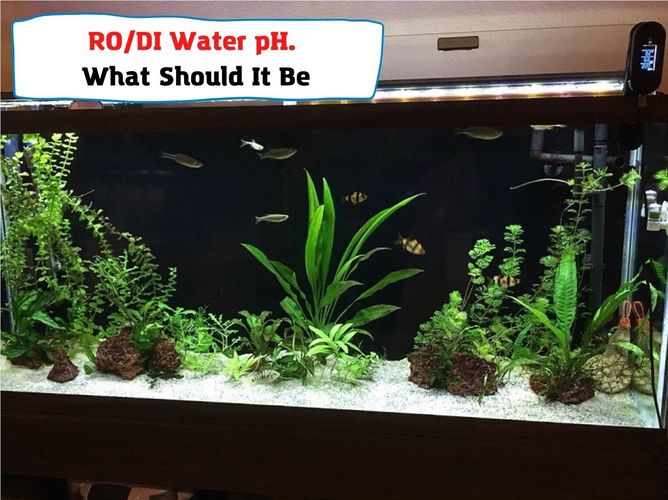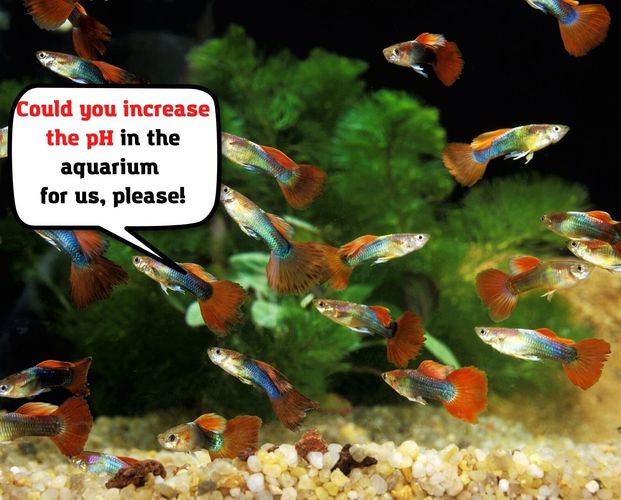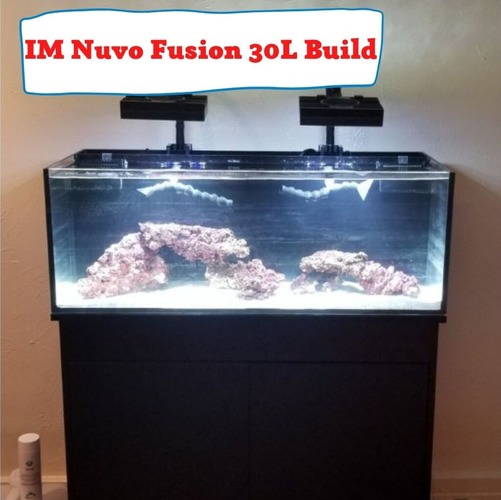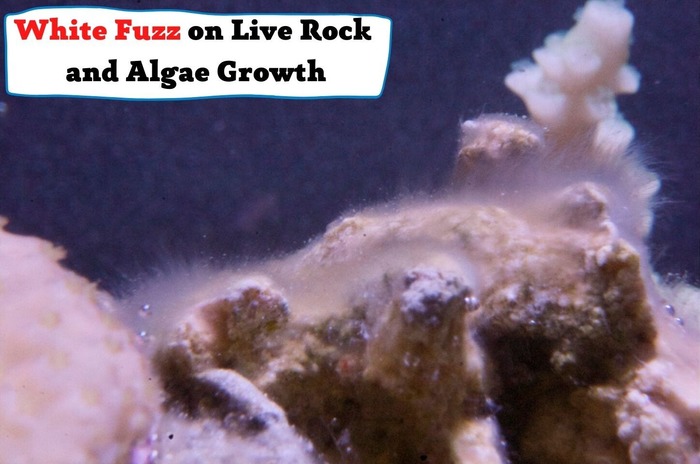
As a newbie, your aquarium could be a mess. In fact, it has to be a mess for the first few months until you understand how things go by. But that is all right. You have to take care of multiple factors within the aquarium water to ensure that your fish are getting the right environment; after all, it is all the environment they have in an aquarium.
So, if you are also facing problems like RO/DI, pH and are unsure what could be causing it, then, in that case, this article is specifically for you, where we’ll address the optimal points of these parameters and the reasons that could be the reason for the deviation.
- What is RO/DI Water?
- What does RO/DI water remove?
- What is the ideal pH of RO/DI water?
- Reasons for not getting the ideal pH
- Interaction with air
- Adding too much of a compound
- Your test kit could be faulty
- Combination of water will not give the average
- So, what should you do?
- Ways to lower pH in Aquarium
- Ways to increase pH in Aquarium
What is RO/DI Water?
RO/DI Water is a special water type that stands for Reverse Osmosis De-Ionized water. There is a special mechanism in which the reverse osmosis water is made to pass through a specified membrane. Even the minute particles tend to stay out of your Aquarium, ensuring a safe environment for your fish.
We are sure that you must be using this process for adding water to your Aquarium. But if you aren’t sure why you are doing this, let us help you with that. When you are adding RO/DI water, it means that the water hardness, chemicals, chlorines, nitrates, and phosphates are reduced in the water by 99%. You are giving a neutral environment to your fish, which is obviously ideal when you want your adjustment parameters essential for your fish’s health.
What does RO/DI water remove?
There are multiple elements that you can expect an RO/DI water system to remove from your water. These include:
Nitrates
Nitrates are caused by a combination of nitrogen and oxygen in the water. Your fish are intolerant to the presence of nitrates and nitrogen in the Aquarium. So, it is essential to keep the nitrates level in your tank from low to a minimum. Using RO water can ensure that the new water entering the Aquarium must have minimum nitrates. So, whatever nitrates are already in the system would be diluted with no further addition.
Phosphates
Similarly, the tolerance of fish towards phosphates is not much high. If your Aquarium has phosphates, it will be highly problematic for the proper sustenance and growth of life in the water. So using RO water, you can keep them out of the tank too.
Silicates
Silicates are present in the water as the contaminant in 90% of everyday water we use. If you utilize the tap water for your tank, you are highly likely to face the pH problem with your water. And using RO water is a way to minimize it.
What is the ideal pH of RO/DI water?

Obviously, considering everything to be perfect as it should be in an ideal environment, the pH of RO/DI water is 7 (totally neutral). But maintaining this might be possible for a few seconds, but you cannot sustain it permanently.
So, you shouldn’t be worrying about it much. Besides, the experts regard the pH of RO/DI water to be insignificant when considering the health of your fish or the overall environment of your water.
So, if it isn’t exactly seven, it is normal, and keeping it there is neither easy nor essential. But you must know the reasons that could drive the pH of RO/DI water. So, you can be careful enough and add the other compounds accordingly, not creating another series of problems for your Aquarium and yourself.
Reasons for not getting the ideal pH
Here are a few reasons to indicate why you are not getting the ideal pH for your RO/DI Water.
Interaction with air
Even if you haven’t added anything to the water yet, the pH of this water will not be seven because of the water’s interaction with the air. The carbon dioxide gas reacts with the water releasing a mildly acidic compound. In most cases, you’ll find the pH of such water near 5.5, i.e., acidic. Still, it isn’t a confirmed or an ideal number. Multiple other factors can impact the pH, including the water temperature; however, it would be acidic on the pH scale.
Adding too much of a compound
Suppose there is no interaction of water with the air. Still, you have added anything extra, considering the large quantities of water in the tank. In that case, the variation in pH can be a lot more than the intended benchmark. Even, the water is fully neutral, the nature of anything you add will reflect in the water pH directly. So, you might be adding too much of a mineral without knowing it.
The exact amount of a compound that might not strongly impact the general aquarium water will have a higher impact on RO/DI water. So, you must be prepared for it.
Your test kit could be faulty
There are multiple instances of a test kit being faulty, so this can be angst for one such reason. Calling a test kit to be faulty doesn’t mean that you should change your brand or buy a new one. It means that the dye you actually have to measure the pH can create a difference in the water pH, and your readings will not be much accurate.
Combination of water will not give the average
If you are mixing water from two resources and expecting your pH meter to provide you with an average or a weighted average, then let us break this news to you that this will not happen. The resultant pH could be a lot more (or a lot different) than the actual pH of each of the water sources. So, if you are taking such a step, your pH meter will show the water pH to be higher than the original pH, thus giving you a faulty number that you cannot rely on.
So, what should you do?
This can be tricky because after reading different articles and forum threads, you will have learned that pH is one of the crucial factors that must be given high importance in your aquarium, whether you have a freshwater tank or a saltwater one.
As far as the RO/DI water for your aquarium is concerned, it must be pure to the maximum extent you can manage, and its pH will not matter much.
If you are adding water to an entirely new tank, you’ll have enough time to check the pH levels of the aquarium water regularly to determine if it is safe for your fish. Similarly, suppose you are adding it as replacement water. In that case, there must be some acidic or basic pH of the water tank already. So, after adding any extra water, you’ll ultimately have to check and maintain the levels.
Thus, the pH of the RO/Di water does not matter in its alone capacity. But that doesn’t mean you can let a malfunctioning system generate your RO/DI water. In such case, your water will not be pure and will indeed create problems for your aquarium and pH maintenance in the tank. So, be vigilant about it.
Ways to lower pH in aquarium
You can use RO/DI water to add buffering to your aquarium, after which you can expect the pH to go lower. Depending on your needs, you can add driftwood pieces to reduce pH even further.
Ways to increase pH in Aquarium

Adding RO/DI water will increase the pH once added to the water. It might be enough considering your needs. If it isn’t, then adding crushed coral or dolomite gravel in the substrate can help you increase the carbonate levels in the water, making it more basic.
Summing up
After going through all this detail, it must be clear that the pH levels of your RO/DI water cannot be in the ideal position, and that is okay; you don’t have to worry about it. Factors like interaction with air, problems in measuring, or impurity of the kits can disrupt pH. So, your goal should be to add pure water to the tank irrespective of its pH.
What matters is the pH of the water in the aquarium. You can adjust it using RO/DI water. Even the inaccurate pH levels can help you manage the tank water to the desired levels. To get things right, you need experience. Till then, you can make minute changes and analyze the results; major experimenting isn’t recommended as it can increase the stress levels of your fish.
- Pleco Not Eating. Main Reasons Your Pleco Is Starving - February 21, 2022
- Foxface Fish Sting: Any Danger? And What To Do To Relieve Pain? - February 20, 2022
- White Stuff Coming Out Of Snail – Dangerous? Should You Worry About It? - February 19, 2022




